Domäne Wachau
by
Terry Sullivan
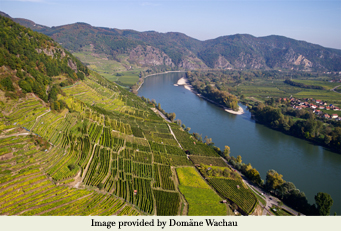 Summary: Domäne Wachau is a cooperative with 250 families farming the vineyards under the direction of the Domäne Wachau winemaker Heinz Frischengruber and winery director Roman Horvath. Terroir is fundamental in the philosophy of vineyards and winemaking. The terraced vineyards, historic cellar, Baroque Summer Palace and tasting the wines in the wine shop provides wine enthusiasts with a memorable experience.
Summary: Domäne Wachau is a cooperative with 250 families farming the vineyards under the direction of the Domäne Wachau winemaker Heinz Frischengruber and winery director Roman Horvath. Terroir is fundamental in the philosophy of vineyards and winemaking. The terraced vineyards, historic cellar, Baroque Summer Palace and tasting the wines in the wine shop provides wine enthusiasts with a memorable experience.
The importance of the terroir of the vineyards takes a center stage at Domäne Wachau. This wine cooperative has the participation of 250 families. Some of these families are second and third generation that have farmed the vineyards of Domäne Wachau. The vineyards are comprised of 440 hectares (almost 1,100 acres).
These families work on stone terraces, some are 800 years old. The terraces are on the steep hillsides overlooking the Danube River as it meanders through the Wachau landscape. In 2000, the Wachau became a UNESCO World Heritage Site. The families that work for the cooperative own their own vineyards. There are incentive programs that will pay premium prices for ultra premium grapes. The work on the terraces is not easy. Working one thousand hours on one hectare vineyards is common. The work must be done by hand.
Our Tour - Vineyards
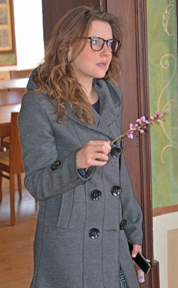 We started our tour with Lena Funke who works in the Export division of Domäne Wachau. We learned that Lena studied oenology and had worked at wineries in New Zealand, Sonoma County in California, Italy, France and Germany. Her masters degree is in international wine marketing. Lena is enthusiastic about all aspects of Domäne Wachau from the vineyards to the wine in the bottle.
We started our tour with Lena Funke who works in the Export division of Domäne Wachau. We learned that Lena studied oenology and had worked at wineries in New Zealand, Sonoma County in California, Italy, France and Germany. Her masters degree is in international wine marketing. Lena is enthusiastic about all aspects of Domäne Wachau from the vineyards to the wine in the bottle.
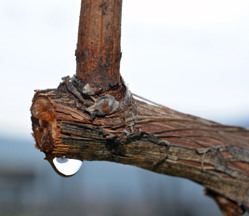 She took us on a walk through some of the vineyards. The vineyard walk was a time of discovery. On the day of our visit, a flowering tree added to the ambiance of the vineyard. The Domäne Wachau vineyards are designated as “Sustainable Austria.” The vineyards are dominated by Grüner Veltliner that accounts for 70% of vineyard plantings. Riesling accounts for 20% of the vines planted in the vineyard. There are fewer plantings of Neuburger, Rivaner, Pinot Blanc and Muskateller for the whites, and Blauer Zweigelt and Pinot Noir for the reds. During our late March visit, the Grüner Veltliner vines were beginning to weep. Early spring vineyard walks give you an opportunity to view the architecture of the vines and observe vines weeping. The vineyard site we were visiting was composed of loose soil with limestone and other rocks.
She took us on a walk through some of the vineyards. The vineyard walk was a time of discovery. On the day of our visit, a flowering tree added to the ambiance of the vineyard. The Domäne Wachau vineyards are designated as “Sustainable Austria.” The vineyards are dominated by Grüner Veltliner that accounts for 70% of vineyard plantings. Riesling accounts for 20% of the vines planted in the vineyard. There are fewer plantings of Neuburger, Rivaner, Pinot Blanc and Muskateller for the whites, and Blauer Zweigelt and Pinot Noir for the reds. During our late March visit, the Grüner Veltliner vines were beginning to weep. Early spring vineyard walks give you an opportunity to view the architecture of the vines and observe vines weeping. The vineyard site we were visiting was composed of loose soil with limestone and other rocks.
Lena is sensitive to the environment. We spotted a flowering tree that was recently pruned. Some of the pruned branches were flowering. Lena picked up one of the flowering pruned branches and carried it with her throughout the tour.
The day was sunny and we were rewarded with a view of a female emerald lizard. This lizard is common in the terraced vineyards. The emerald lizard is also the patron for the Smaragd category of wines. Not far from our emerald lizard sighting, we saw the insect hotel. The structure is designed to attract beneficial insects. A strong population of beneficial insects in the vineyards help control the harmful insects.
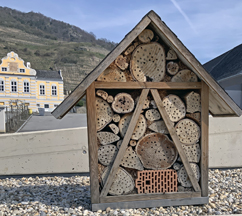
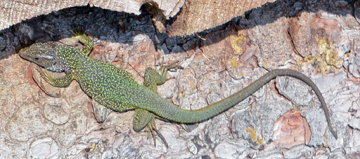
Our Tour - The Baroque Cellar Palace
Surrounded by vineyards, the yellow colored Baroque Cellar Palace stands out as a landmark in Dürnstein. The structure was built by Jakob Prandtauer between 1714 and 1719. Historically the palace was used as a residence of Hieronymus Übelbacher, Apt of the Dürnstein Abbey, who used the building for entertainment. Ceilings are painted with colorful scenes and the walls are covered with numerous images of all sizes.
Today, Domäne Wachau uses the palace for wine tastings, special events and as a wine archive. Palace visits are included with some of the tours offered by the winery.
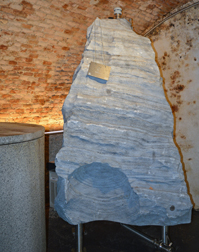 Our Tour - Cellars
Our Tour - Cellars
During our amble through the vineyard we learned that the winery also has deep roots. Parts of the winery date back to 701. At that time grapes were planted, farmed and wine made by priests. The cellar was built in 1714. During our cellar tour we observed many barriques and wood casks. Some had engraved heads showing scenes from the area.
One section of the cellar was the experimental section. In this section we observed concrete tanks, qvevri, a granite tank and an unusual marble tank. The marble tank (pictured left) had the inside removed and wine was aging in it. The winery also distills Grüner Veltliner and ages the spirit in oak barrels. A port-styled wine is also made. Later we had a chance to taste one of the Riesling wines made in the qvevri.
Domäne Wachau currently makes between 2.5 and 3 million bottles of wine and has world-wide distribution including the United States.
Wines
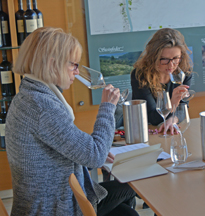 Lena conducted our wine tasting in the Vinothek shop. Our first wine was the 2018 Grüner Veltliner Federspiel, Terrassen. This wine is the backbone of Domäne Wachau and is available in the United States. The grapes for this wine were blended from different vineyard sites. The wine had a yellow color and 12.5% alcohol. The aroma was citrusy while the taste had citrus and white peaches. The crisp finish had citrus yielding to mineral on the aftertaste.
Lena conducted our wine tasting in the Vinothek shop. Our first wine was the 2018 Grüner Veltliner Federspiel, Terrassen. This wine is the backbone of Domäne Wachau and is available in the United States. The grapes for this wine were blended from different vineyard sites. The wine had a yellow color and 12.5% alcohol. The aroma was citrusy while the taste had citrus and white peaches. The crisp finish had citrus yielding to mineral on the aftertaste.
The 2018 Grüner Veltliner Federspiel, Liebenberg Vineyard was a light yellow color with a green hue and 12.5% alcohol. Yellow stone fruit and citrus were noticed on the aroma. The taste had a silky mouthfeel and traces of citrus and white peaches. The finish was crisp with citrus and a hint of mineral.
The 2018 Riesling Federspiel, Bruck Vineyard, was a light yellow color with 12.5% alcohol. The wine had a floral aroma. The taste was reminiscent of honeysuckle and peaches with a silky mouthfeel. The finish had a hint of oiliness and was floral.
The 2017 Grüner Veltliner Smaragd, Kellerberg Vineyard, had a yellow color with a gold hue and 14% alcohol. It had a floral aroma. The mouthfeel was silky and the taste included white peaches and honeysuckle. The fruity finish yielded to a hint of mineral.
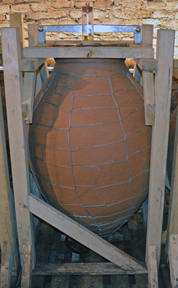
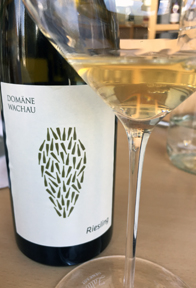 The 2017 Riesling Smaragd, Achleiten Vineyard, had a light yellow color and 14% alcohol. The aroma had layers of flowers, peaches and mineral. The taste had a silky mouthfeel with honeysuckle, peaches and mineral. The finish was initially floral and fruity. Then there was an onset of citrus enveloping the aftertaste with a hint of mineral.
The 2017 Riesling Smaragd, Achleiten Vineyard, had a light yellow color and 14% alcohol. The aroma had layers of flowers, peaches and mineral. The taste had a silky mouthfeel with honeysuckle, peaches and mineral. The finish was initially floral and fruity. Then there was an onset of citrus enveloping the aftertaste with a hint of mineral.
Our final wine was a 2016 Riesling Amphora (Qvevri) that had a light gold color and 12.5% alcohol. My first impression was that this wine reminded me of the qvevri wines we make in Maryland in a small buried qvevri. The wine was fermented and aged on its skins for six months. The aroma was floral and the taste was reminiscent of roses, honeysuckle and mineral. The wine was full bodied and had mild tannins. It had a floral finish.
When visiting the Wachau wine region, visit Domäne Wachau for gaining a great background to this region and the wines that are crafted.
Domäne Wachau
Dürnstein 107, 3601 Dürnstein, Austria
Article written April 2019.
